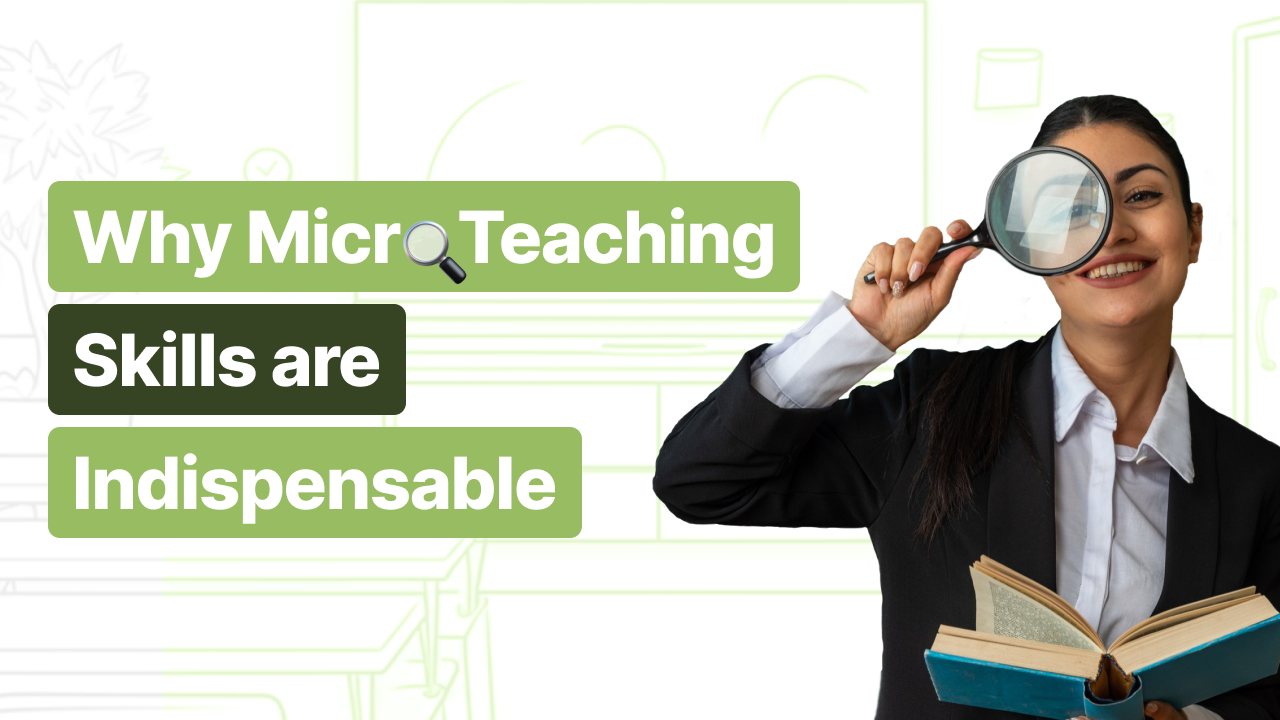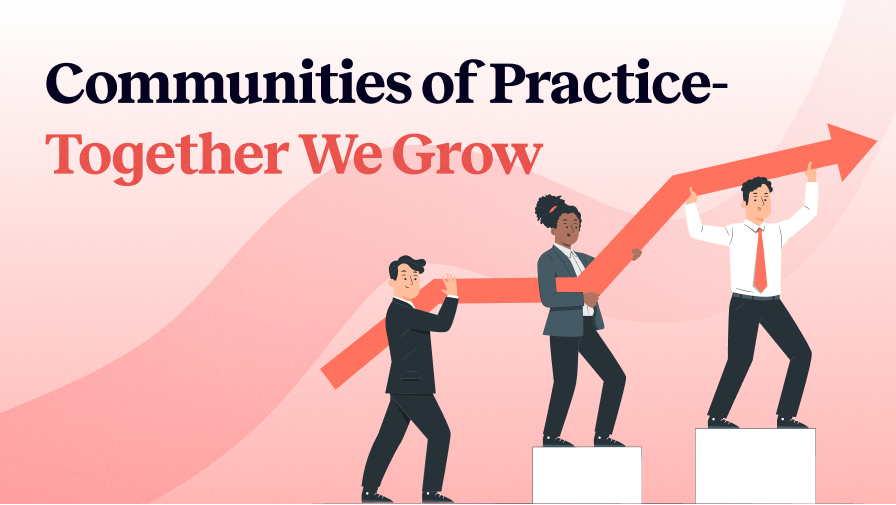Imagine students who thrive not just in the classroom, but throughout their lives. They're more likely to graduate high school, pursue higher education, and secure a well-paying job. They might even build a future that promises security and success. These aren't just dreams; they're the documented outcomes associated with having qualified & skilled teachers in the classroom.
The influence of a quality teacher extends far beyond standardized test scores. It shapes students' aspirations and equips them with the skills to shape a better future for themselves.
But how do we ensure teachers have the tools to consistently unlock this kind of potential? This is where teacher professional development (PD) comes in.
In this blog, we'll delve into the world of teacher professional development, exploring:
- What is Teacher Professional Development?
- Why is Teacher Professional Development Important?
- What are the Different Types Pathways for Professional Development of a Teacher?
- 5-Step Process to Choose the Right Teacher Professional Development Path for Yourself
- Choosing a Professional Development Pathway Based on Your Teaching Experience
By the end of this blog, you'll be equipped with the knowledge and resources to start your own professional development journey. Let’s begin by understanding the meaning of teacher professional development.

Teacher professional development (PD) is more than just attending a workshop, completing a course or attending a conference. It's a continuous process of reflection, learning, and action. It is designed to elevate your teaching practice and ultimately, drive student outcomes.
At its core, professional development empowers you to engage in self-reflection, critically analyze your teaching methods and strategies to identify areas for improvement.
It is a journey towards professional growth that instills a lifelong learner mindset. You tend to continuously seek out new knowledge, refine your skills, and adapt your teaching methods to meet the evolving needs of your students.
Let's delve deeper into why is Teacher Professional Development important in our next section below.
We've established what is teacher professional development (PD). But what's in it for you as a teacher? Why is teacher professional development important?
The benefits of professional development for teachers are vast and far-reaching, extending far beyond acquiring new skills. Let's explore some of the ways PD empowers teachers to excel in their profession:
1. Keeping Pace with Change

The world of education is no longer static. New technologies emerge, student needs diversify, and educational best practices are continuously refined.
Professional development equips you with the latest knowledge and skills to navigate these changes effectively. Whether it's integrating technology into the classroom, implementing new curriculum standards, or addressing the diverse learning styles of students—professional development of teachers ensures that they remain at the forefront of their practice.
2. Boosting Student Achievement

Effective Professional development of a teacher directly translates to improved student outcomes. When you participate in high-quality teacher professional development courses or programs, you gain access to research-based instructional strategies proven to enhance student learning.
This can lead to higher test scores, improved critical thinking skills, and a deeper understanding of subject matter for your students.
3. Providing Career Advancement Opportunities
Teacher professional development demonstrates your commitment to lifelong learning and continuous improvement. Participation in teacher professional development courses can enhance your resume.
This signals to potential employers that you're a proactive educator who is invested in their own continuous professional development and student success.Thus, opening doors to leadership positions within the school, and outside.
4. Fostering a Collaborative Learning Environment
Many PD experiences provide opportunities for you to connect with your peers, share best practices, and learn from each other's successes and challenges.

This collaborative environment fosters a sense of community and support, allowing you to exchange ideas, problem-solve collectively, and continuously refine their teaching approaches. Plus, you can develop creative solutions to classroom challenges and continuously refine your teaching approaches together.
5. Gaining Confidence and Self-Efficacy

As you master new skills and strategies through PD, your confidence in the classroom grows. You feel more equipped to handle challenging situations, experiment with innovative approaches, and inspire your students.
This sense of self-efficacy fosters a positive learning environment where both you and your students feel empowered to take risks and embrace challenges.
6. Increased Job Satisfaction and Reduced Burnout

Teacher burnout is a real concern, but PD can be a powerful antidote. By providing opportunities for growth, challenge, and skill development, PD can reignite your passion for your craft.
Learning new strategies, collaborating with colleagues, and witnessing the positive impact on student learning can all contribute to a more positive and fulfilling work experience. This translates into increased job satisfaction, reduced stress levels, and a renewed sense of purpose within the profession.

As we've seen, there are many benefits of teacher professional development. It is more than just a box to check. It's a powerful investment in your personal and professional growth that benefits both you and your students.
PD empowers you to stay current, refine your skills, and ignite your passion for teaching. In the next section, we'll delve into the various types of PD available, catering to different learning styles, interests, and career goals.

Teacher professional development (PD) comes in all shapes and sizes, catering to diverse learning styles, interests, and career goals. Here's a glimpse into the rich buffet of PD options available:
A. Formal Teacher Professional Development

This category encompasses structured learning experiences with a set curriculum and facilitators. These PD avenues often involve clear learning objectives, regular assessments, and opportunities for application to ensure you translate theory into practical classroom strategies.
Examples include:
- Workshops and Conferences: Attend focused sessions on specific topics like integrating technology, differentiated instruction, or curriculum implementation.
Register for Suraasa Masterclasses to connect with international experts & get valuable insights for career growth!
- Online Professional Development Courses: Join virtual programs that help you gain valuable knowledge and skills at your own pace covering a variety of topics.
- University-level CPD Training for Teachers: Pursue advanced degrees or certifications to deepen your expertise and potentially qualify for leadership roles.
- Job-Embedded PD: Integrate professional learning directly into the classroom context. This allows you to apply new strategies and receive feedback in real-time.
- Action Research: Engage in systematic inquiry into your own practice, identifying areas for improvement, implementing interventions, and evaluating their impact on student learning.
- Educational Leadership Programs: Designed for aspiring school leaders, these teacher professional development courses provide training in instructional leadership, management, and organizational development, preparing you for administrative roles.
- Mentorship Programs: Pairing novice teachers with experienced mentors provides personalized guidance and support, facilitating the transfer of knowledge and skills from seasoned educators to newcomers.
B. Informal Teacher Professional Development

These PD approaches offer a flexible and collaborative approach to professional development. You take charge of your own learning journey by exploring topics and strategies that pique your interest. It is ideal for you if you’re a busy teacher who can dedicate time at their own pace.
Examples include:
- Peer Coaching: Observe colleagues in action, provide constructive feedback, and learn from each other's practices.
- Lesson Study Groups: Collaborate with colleagues to plan, implement, observe, and analyze a specific lesson, fostering collective improvement.
- Book Clubs: Discuss educational texts with colleagues, gleaning new insights and perspectives.
- Self-Directed Learning: Independently research educational best practices, explore new teaching resources, and experiment with innovative approaches in your classroom.
- Communities of Practice: Engage in informal networks of educators sharing knowledge, resources, and best practices, fostering a sense of camaraderie and professional growth.
- Social Media and Online Communities: Join platforms like Instagram, LinkedIn, and educational blogs that offer opportunities for educators to connect, share ideas, and participate in virtual PD sessions.
- Microlearning: Learn via bite-sized learning modules, podcasts, and videos that allow you to access quick, focused professional development on-the-go.
- Reflective Practice: Engage in regular self-reflection and journaling to assess your teaching practices, set goals for improvement, and track your progress over time.
Feeling overwhelmed by the vast array of teacher professional development (PD) options? You're not alone! But fear not!

By following this strategic 5-step process, you can easily choose the perfect program from this buffet of learning opportunities that caters to your professional growth.
Step 1: Self-Discovery - Identifying Your Needs and Goals
Every successful PD journey begins with introspection. Grab a pen and paper, or turn up your favorite journaling app, and sit for a self-reflective session. Here's what to focus on:
- Strengths & Weaknesses: Honestly assess your current teaching skills and identify areas where you excel and those that require further development. Consider classroom management, subject matter knowledge, integrating technology, or catering to diverse learning styles.
- Student Needs: Shift your focus to your students. Are there specific learning gaps you've observed? Is there a particular content area where a more tailored approach is needed? Identifying your students' needs will help you prioritize relevant PD opportunities.
- SMART Goals: Once you have a clearer picture, translate your insights into SMART goals (Specific, Measurable, Achievable, Relevant, and Time-bound). For instance, a goal might be: "To improve student engagement in science lessons by incorporating technology-based simulations by the end of the semester". These focused goals will act as a compass guiding you towards the most impactful PD experiences.
Step 2: Finding Your Perfect Fit: Matching Opportunities to Your Goals
With your SMART goals in mind, it's time to delve into the exciting world of PD options! Here are some resources to kick-start your search:
- School & District Resources: Many schools and districts offer in-house PD programs, workshops, and mentoring opportunities. Explore what's available within your immediate network. Don't hesitate to speak with your department head or school principal for recommendations.
- Subject Area Associations: Professional organizations dedicated to your specific teaching area are a treasure trove of PD opportunities. They often hold conferences, online courses, and develop resources specifically tailored to the unique needs of educators in your field.
- The Power of Internet: The internet offers a wealth of resources, from educational blogs and webinars to comprehensive online professional development courses provided by universities and educational institutions. Leverage the power of the web to find relevant and convenient learning opportunities that fit your schedule.
Step 3: Prioritization & Informed Choices - Making the Smart Investment

Not all PD experiences are created equal. Before diving headfirst, consider these factors to ensure you're making informed choices:
- Alignment with Goals: Does the PD program directly address your identified needs and SMART goals?
- Credibility & Reputation: Research the facilitators or sponsoring organizations to ensure the content is high-quality and grounded in educational best practices.
- Learning Format: Consider your preferred learning style. Do you thrive in interactive workshops with opportunities for collaboration, or do you prefer the flexibility and self-paced nature of online professional development courses?
- Cost & Time Commitment: Be realistic about your budget and time constraints. Many free or low-cost PD options exist alongside high-quality premium programs. Choose opportunities that offer a strong return on investment for your time and resources.
Step 4: Active Participation & Reflection - Maximizing Your Learning

Simply enrolling in a teacher professional development course isn't enough. To truly maximize your learning, approach each experience with an active and engaged mindset. Here are some tips to get the most out of your chosen PD:
- Set Clear Expectations: Before participating, establish specific learning objectives for yourself. What specific knowledge or skills do you hope to gain?
- Active Engagement: Don't be a passive observer! Ask questions, participate in discussions, and take detailed notes to solidify your learning.
- Connecting the Dots: Continuously reflect on how the new knowledge and skills you're acquiring can be applied to your own classroom practice. Consider how these learnings can benefit your students and address the challenges you identified in Step 1.
- Action Plan & Follow-Through: Create a concrete plan for implementing what you've learned. Set a timeline, identify resources you might need (materials, technology, etc.), and establish a system for monitoring your progress.
Step 5: Continuous Growth - Cultivating a Lifelong Learning Mindset

Effective teacher professional development is a lifelong journey, not a one-time event. By fostering a growth mindset and embracing continuous learning, you'll ensure your teaching practice remains dynamic and responsive to the ever-evolving needs of your students and the educational landscape. Here are some tips for that:
- Schedule Time for Reflection: Regularly reflect on your teaching practice, student progress, and areas for growth. Use these insights to identify your next PD goals.
- Stay Connected with Colleagues: Build a professional learning network (PLN) to share ideas, learn from others, and stay inspired.
- Embrace Experimentation: View your classroom as a laboratory for learning. Experiment with new strategies gleaned from PD and assess their impact on your students.
- Celebrate Growth: Acknowledge and celebrate your progress, no matter how small. Reflect on how PD has transformed your teaching and benefited your students.
- Stay Current with Trends: Dedicate time to staying abreast of current educational research and best practices. This ensures your teaching remains relevant and responsive to student needs.
By following these five steps, you can choose the perfect Professional development course for yourself. Remember, the ideal PD journey is a blend of self-discovery, exploration, informed choices, active participation, and a commitment to continuous learning.
In the next section, we'll explore how to tailor this 5-step process to cater to the diverse needs and preferences of different educators. We'll delve into strategies for veteran teachers seeking to refine their craft, new educators navigating the initial years of their careers, and educators with specific subject matter expertise looking to deepen their knowledge.
The beauty of teacher professional development (PD) lies in its ability to empower teachers at every juncture of their careers.
While the core 5-step process (Self-Discovery, Finding Your Perfect Fit, Informed Choices, Active Participation, Continuous Growth) serves as a solid foundation. It can be customized to address the unique needs and aspirations of New Teachers, In-Service Teachers, Seasoned Teachers, and Veteran Teachers.
Here's how you can tailor your PD journey based on your experience level:
1. The New Teacher (Less than 1 Year Experience): Building a Solid Foundation

The first year of teaching is an immersive experience, filled with both challenges and triumphs. Here are some tips to jumpstart choose the teacher professional development course for yourself:
- Prioritize Subject Matter Expertise: Enroll in PD programs or online CPD teacher training courses directly aligned with your specific content area. These resources will bolster your confidence and equip you to deliver clear and engaging lessons.
- Seek Mentorship Opportunities: Connect with experienced educators in your subject area or school. A mentor can be a guiding light, offering invaluable support and advice as you navigate the complexities of your first year. Don't hesitate to ask questions, observe their classroom practices, and learn from their wealth of experience.
- Focus on Classroom Management: Effective classroom management is the cornerstone of a positive learning environment. Explore workshops or online resources focused on developing strong classroom management skills.
Mastering techniques for establishing routines, procedures, and positive expectations will empower you to create a space where students feel safe, supported, and ready to learn.
2. The In-Service Teacher (1-5 Years Experience): Refining and Expanding

With a few years of experience under their belts, In-Service Teachers are ready to refine their existing skills and explore new approaches to teaching and learning. Here's how to optimize your PD journey:
- Deepen Pedagogy Knowledge & Differentiation: Consider PD opportunities that allow you to delve deeper into your pedagogical expertise, while also exploring strategies for effective differentiation. These experiences will enhance your content expertise and equip you to cater to the diverse learning styles and needs within your classroom.
- Collaboration & Best Practices: Connect with colleagues through workshops or online communities focused on sharing best practices and collaborating on new instructional strategies. Learning from and alongside other educators can spark innovation, provide fresh perspectives, and help you refine your teaching practice.
- Technology Integration: Stay current with the latest educational technology trends by attending workshops or webinars focused on integrating technology into your teaching in engaging and effective ways. These resources will help you leverage the power of technology to enhance student learning, create interactive lessons, and cater to diverse learning styles.
3. The Seasoned Teacher (5-10 Years Experience): Leading and Innovating

Seasoned Teachers have a wealth of experience and knowledge to share. Their PD journey can focus on leadership development and exploring innovative approaches to teaching and learning. Here are some tips:
- Mentorship & Curriculum Development: Consider PD opportunities that allow you to share your expertise with colleagues. Coaching programs or workshops on curriculum development can be rewarding experiences, allowing you to contribute to your school's educational growth while also supporting the development of new teachers.
- Action Research & Innovation: Engage in action research projects within your classroom to explore innovative teaching methods and contribute to the broader educational knowledge base. These projects allow you to experiment with new strategies, assess their effectiveness, and potentially share your findings with other educators, shaping best practices within the field.
- Leadership Roles: Look for PD programs that prepare you for leadership roles within your school or district, such as instructional coaching or department chair positions. These opportunities allow you to leverage your experience to guide and support other educators, fostering a collaborative and innovative school environment.
4. The Veteran Teacher (More than 10 Years Experience): Sustaining Excellence and Mentorship

Veteran Teachers are pillars of educational expertise. Here are some tips on what their PD journey can focus on:
- Staying Current: Dedicate time to staying abreast of current educational research and best practices. Subscribe to educational journals, follow educational blogs and social media influencers, and attend webinars on emerging trends in your field. This ongoing commitment to learning ensures your teaching practice remains relevant, responsive, and addresses the ever-evolving needs of your students.
- Mentorship & Sharing Expertise: Become a mentor for new or in-service teachers, sharing your wealth of knowledge and experience to help them grow and thrive. Mentorship allows you to give back to the profession, fostering a supportive and collaborative school culture where all educators can flourish.
- Reflective Practice: Engage in regular self-reflection to assess your teaching practice and identify areas for continuous improvement. Schedule time for journaling, discuss your practice with colleagues or mentors, and consider soliciting student feedback. By reflecting on your strengths and areas for growth, you can ensure your PD journey remains purposeful and impactful.
Remember, the key to a successful PD journey lies in intentionality. Regularly reflect on your needs, goals, and preferred learning styles. By strategically utilizing the 5-step process and tailoring it to your specific career stage, you can ensure your PD experiences are enriching and translate into a dynamic and impactful classroom environment for your students.

The journey of teacher professional development (PD) is a transformative one. It equips you with the knowledge, skills, and strategies to become a more effective educator, fostering a positive and engaging learning environment for your students.
By following the 5-step process outlined in this blog and tailoring it to your specific experience level, you can embark on a personalized PD journey that fuels your passion for teaching and empowers you to make a lasting impact on your students' lives.
As you continuously develop your teaching practice, you'll not only witness positive transformations in your classroom but also contribute to a brighter future for the next generation.
So, are you ready to embark on your own PD adventure? Take the first step today and begin crafting a roadmap for your lifelong learning journey!
















